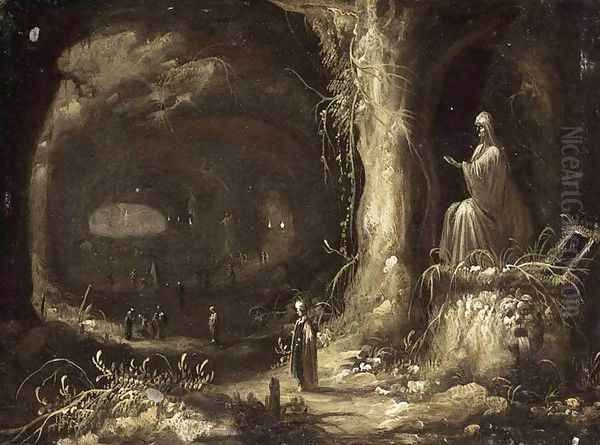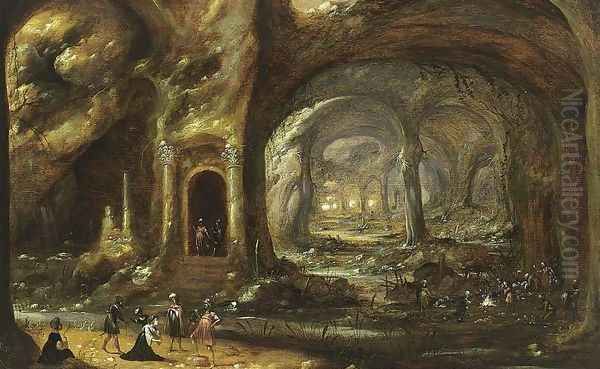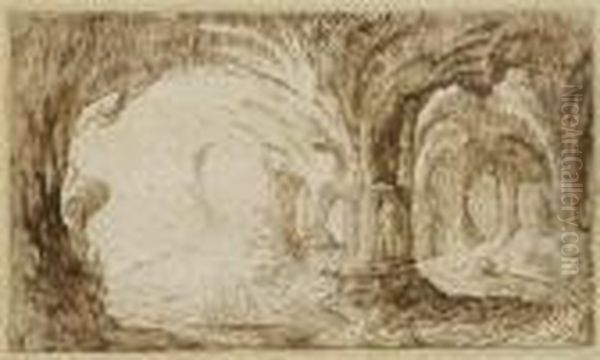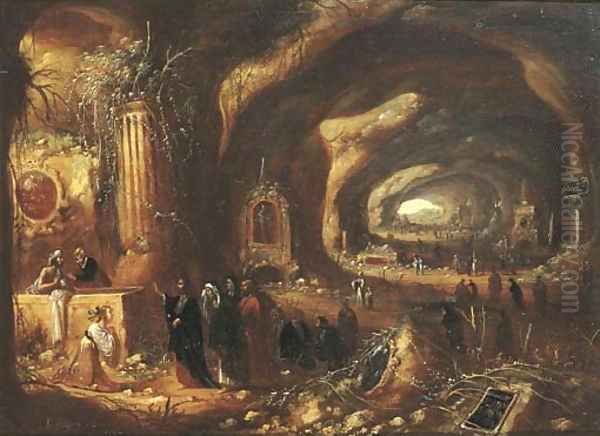Rombout van Troyen (circa 1605 – circa 1656) stands as a distinctive, if sometimes overlooked, figure in the rich tapestry of Dutch Golden Age painting. While his contemporaries like Rembrandt van Rijn or Johannes Vermeer achieved monumental fame for their portraiture, genre scenes, or serene interiors, Van Troyen carved a unique niche for himself. He specialized in imaginative, often diminutive, paintings of grottoes, caves, and fantastical architectural ruins, frequently populated with small figures enacting biblical or mythological narratives. His work offers a fascinating glimpse into a less-traveled path of Dutch art, one that embraced the eerie, the ancient, and the imagined landscape, all while navigating a challenging personal life and a competitive art market.
Early Life and Artistic Formation
Born in Amsterdam around 1605, Rombout van Troyen hailed from a family of artisans, an environment that likely provided an early exposure to craftsmanship and artistic endeavors. His formal artistic training commenced in 1615 or 1616 when he was apprenticed to the studio of Jan Pynas. This apprenticeship was a significant formative period, lasting at least seven years. Jan Pynas (c. 1583-1631) was a prominent figure among the group of artists known as the Pre-Rembrandtists, painters who were active in Amsterdam before Rembrandt’s rise to dominance and who often depicted historical and biblical scenes with a dramatic flair influenced by Italian art, particularly the works of Adam Elsheimer.
During his extended tutelage under Jan Pynas, Van Troyen would have absorbed not only technical skills but also thematic preoccupations. The influence of Jan Pynas is evident in Van Troyen's later penchant for historical and biblical subjects. Furthermore, he was also exposed to the artistic currents of Jan's brother, Jacob Pynas (c. 1592-c. 1650), another Pre-Rembrandtist with a similar stylistic leaning, and Bartholomeus Breenbergh (1598-1657). Breenbergh was a leading figure among the first generation of Dutch Italianate painters, artists who traveled to Italy and returned with a style characterized by warm, golden light and depictions of Roman ruins and pastoral landscapes. Though Van Troyen himself never journeyed to Italy, Breenbergh's influence, perhaps transmitted indirectly or through accessible works, profoundly shaped his vision of fantastical, ruin-laden landscapes.
Shift in Focus: The Allure of the Grotto

Van Troyen's early artistic output reportedly included more conventional landscape and historical paintings. However, over time, his focus narrowed and intensified, leading him to specialize in a rather unique genre: the grotto or cave painting. These works became his hallmark. He developed a distinct ability to create atmospheric, often somber, subterranean worlds, illuminated by carefully managed light sources that cast deep shadows and highlighted intricate rock formations or crumbling ancient architecture.
His grottoes were rarely empty; they served as dramatic stages for narratives drawn primarily from the Bible and classical mythology. These scenes were typically rendered with small, meticulously detailed figures, dwarfed by the grandeur and mystery of their surroundings. This contrast in scale emphasized the vulnerability of humans against the vastness of nature or the weight of history and divine power. The choice of subject matter – often dramatic or poignant moments – resonated with the theatrical potential of the cave setting.
Artistic Style and Thematic Concerns
Rombout van Troyen’s mature style is characterized by several key elements. His paintings are generally small in scale, demanding close inspection to appreciate their intricate details. He was a master of chiaroscuro, using contrasts of light and shadow not only to model form but also to create a sense of mystery, depth, and drama. A soft, often ethereal light typically penetrates the gloom of his caves, selectively illuminating key figures or architectural features, guiding the viewer's eye through the composition.
His palette tended towards earthy tones, with browns, grays, and ochres dominating, punctuated by occasional touches of richer color in the figures' drapery. This subdued coloration enhanced the subterranean atmosphere and the sense of antiquity. Despite the fantastical nature of his settings, Van Troyen paid considerable attention to the texture of rock, the decay of ruins, and the rendering of foliage, lending a degree of verisimilitude to his imagined worlds.
Thematically, his works reveal a profound engagement with religious and mythological narratives. He demonstrated a deep understanding of these stories, choosing moments ripe with emotional or moral significance. The cave setting itself, a liminal space between the known world and the unknown, often carried symbolic weight, representing refuge, trial, revelation, or the underworld.
Notable Works: Windows into Imagined Worlds
Several of Rombout van Troyen's works exemplify his unique artistic vision. Interior of a Grotto is a quintessential example, showcasing his ability to render the complex, irregular forms of a cave interior, with light filtering in to reveal figures within its depths. The play of light and shadow creates a palpable sense of enclosure and mystery.

A Cave with Soldiers Capturing a Woman demonstrates his skill in integrating narrative into his grotto scenes. The dramatic action, though depicted with small figures, is charged with tension, amplified by the ominous, cavernous setting. The viewer is drawn into the unfolding drama, the cave walls almost echoing the implied sounds of the struggle.
Biblical themes were central to his oeuvre. The Exile of Nebuchadnezzar (also referred to as The Pit of King Nebuchadnezzar) portrays the Babylonian king's period of madness, living in the wilderness. Van Troyen’s interpretation often places Nebuchadnezzar in a desolate, cave-like environment, emphasizing his isolation and degradation. Another biblical subject he tackled was Ahaz Sacrificing His Son, a harrowing Old Testament story that Van Troyen would have imbued with the dramatic intensity characteristic of his style, likely set against a stark, perhaps ruinous, backdrop.
Mythological subjects also captured his imagination. A painting titled Andromeda would have depicted the classical myth of the princess chained to a rock as a sacrifice to a sea monster, a theme allowing for the dramatic interplay of a vulnerable figure within a rugged, rocky coastal or cave setting. Works like The Burning of Sodom provided ample opportunity for dramatic light effects and scenes of chaos and divine retribution, themes well-suited to his artistic temperament. Cave with Figures is a more general title that could apply to many of his works, underscoring his consistent focus on human presence within these natural or man-made subterranean spaces. Priest Blessing a Young Woman suggests a more serene, perhaps allegorical scene, but still likely set within an atmospheric architectural or grotto-like interior, allowing for his characteristic light effects.
The Italianate Dream Without Italy
A remarkable aspect of Van Troyen's art is its strong Italianate flavor, despite the fact that he, unlike many of his contemporaries such as Cornelis van Poelenburgh, Jan Both, or Nicolaes Berchem, never traveled to Italy. His depictions of classical ruins, sun-dappled landscapes (albeit often within or viewed from caves), and mythological themes echo the work of artists who had experienced the Italian peninsula firsthand.

This "Italianism by proxy" was likely absorbed through several channels. His training under Jan Pynas, who himself had Italian influences, was foundational. The works of artists like Bartholomeus Breenbergh, who had spent considerable time in Rome, were also accessible in Amsterdam and would have provided models. Furthermore, prints and drawings of Italian scenes circulated widely, offering artists who remained in the Netherlands a visual vocabulary of classical antiquity and Mediterranean landscapes. Van Troyen skillfully synthesized these influences into his own unique vision, creating a dream-like Italy of the mind, filtered through the shadowy ambiance of his grottoes.
A Life of Personal and Financial Turmoil
Rombout van Troyen's personal life was marked by considerable hardship. He married at least twice and fathered at least seven children. Tragically, it appears that only one daughter survived to adulthood, a common yet devastating reality in the 17th century. Beyond these personal losses, Van Troyen struggled significantly with poverty and accumulating financial debts.
His financial desperation led to an extraordinary and dramatic act. Around 1637, to escape his creditors, Van Troyen orchestrated the forgery of his own death certificate or obituary. Having "died" on paper, he then fled Amsterdam and resurfaced in Leeuwarden, the capital of Friesland. This move was perhaps strategically timed; an outbreak of plague in Leeuwarden in 1637 had created vacancies in the local art market, potentially offering new opportunities for an artist seeking a fresh start, however illicitly obtained. This episode, while speaking to his dire straits, also highlights a certain resourcefulness, or perhaps recklessness, in the face of adversity.
Navigating the Amsterdam Art Market
Despite his personal struggles and the somewhat niche appeal of his specialized subject matter, Rombout van Troyen managed to establish a presence in the competitive Amsterdam art market. His paintings, though generally commanding lower prices than those of more celebrated masters, found buyers. He was known for his diligence and prolific output, which helped him gain a market share among collectors of more modest means. He became, as some art historians have noted, a "star of modest collections."
His career reflects the diversity and dynamism of the Dutch Golden Age art world. It wasn't solely dominated by giants like Rembrandt or Frans Hals; there was room for specialists catering to various tastes and budgets. Van Troyen's success, however modest, demonstrates that an artist with a unique vision and a strong work ethic could find a place, even if it meant operating on the periphery of mainstream trends. His work appealed to a clientele perhaps drawn to the imaginative, the slightly melancholic, or the antiquarian charm of his grottoes and ruins.
The Broader Context: Dutch Golden Age Painting

To fully appreciate Van Troyen's contribution, it's essential to place him within the broader context of 17th-century Dutch art. This era witnessed an unprecedented flourishing of painting, fueled by economic prosperity, national pride, and a burgeoning middle class eager to adorn their homes with art. Unlike in Catholic countries where the church was a primary patron, in the Protestant Netherlands, patronage was more diverse, encompassing civic institutions, guilds, and private citizens.
This led to a remarkable specialization among artists. While Van Troyen focused on his grottoes, other painters excelled in distinct genres. Portraitists like Frans Hals and Rembrandt captured the likenesses of the era's prominent citizens. Landscape painters such as Jacob van Ruisdael and Meindert Hobbema depicted the Dutch countryside with unparalleled realism and atmospheric depth. Marine painters like Willem van de Velde the Younger celebrated the nation's maritime prowess. Genre painters, including Jan Steen, Adriaen Brouwer, and Gerard Dou (a pupil of Rembrandt), offered lively, often humorous, glimpses into everyday life. Still-life painters, such as Willem Claesz. Heda and Rachel Ruysch, rendered opulent displays of food, flowers, and objects with breathtaking precision.
Van Troyen's Italianate leanings, even without direct travel, connected him to another significant trend: the fascination with Italy. Artists like the previously mentioned Breenbergh, Poelenburgh, Jan Both, and later Nicolaes Berchem and Jan Asselijn, either traveled to Italy or emulated the Italianate style, bringing a Mediterranean warmth and classical sensibility to Dutch art. Van Troyen’s work, with its focus on ruins and mythological scenes, shares thematic ground with these artists, even if his execution and preferred settings (the shadowy grotto) were distinctly his own.
Legacy and Historical Assessment
Rombout van Troyen's art, while perhaps not as widely influential as that of some of his more famous contemporaries, holds a secure place in the history of Dutch art. He was a distinctive master of a particular type of imaginative landscape, one that blended observation of the natural world (or at least its textures and forms) with a strong element of fantasy and narrative. His ability to create evocative, atmospheric scenes within the confines of small panels is noteworthy.
His work demonstrates the breadth and variety of the Dutch Golden Age art market, showing that there was an appetite for subjects beyond straightforward depictions of Dutch life and landscape. His grottoes, with their blend of the natural and the artificial, the ancient and the timeless, offered viewers an escape into imagined realms, tinged with melancholy and wonder.
While the dramatic episode of his faked death adds a colorful, if somber, note to his biography, it is his artistic output that secures his legacy. His paintings are found in various museums and private collections, attesting to their enduring, if quiet, appeal. He influenced, to some degree, later artists who explored similar themes of ruins and fantastical landscapes, though direct lines of influence can be hard to trace definitively. He remains a testament to the artistic ingenuity and personal resilience required to forge a career in the vibrant, yet challenging, art world of 17th-century Holland.
Conclusion: A Painter of Shadow and Imagination
Rombout van Troyen was an artist who charted his own course. From his apprenticeship with Jan Pynas, he developed a fascination with historical and mythological narratives, which he then uniquely transposed into the shadowy, enigmatic settings of caves and grottoes. Though he never saw Italy, its artistic spirit permeated his work, resulting in a highly personal vision of classical antiquity and imagined landscapes. His life was one of artistic dedication amidst personal tragedy and financial hardship, culminating in a desperate flight from debt. Yet, through it all, he continued to produce a body of work that is both distinctive and evocative. As a painter of these miniature, mysterious worlds, Rombout van Troyen contributed a unique and intriguing chapter to the grand narrative of Dutch Golden Age art, reminding us of the diverse paths taken by artists in this extraordinarily creative period.